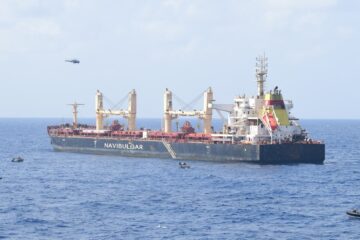The Indian Navy announced on January 24 that it successfully engaged a land-based target at enhanced range using the BrahMos supersonic cruise missile. Images of the missile launch released by the Navy revealed that the test was conducted from a Rajput-class destroyer, either INS Ranvir or INS Ranvijay.
The BrahMos is the preferred offensive missile used by the Indian Navy and its various versions are tested often. The January 24 test, which proved “extended range precision strike capability from combat & mission ready ships”, was notable due to the area warning that coincided with the test. A no fly zone was notified between January 24 and 25, with a maximum length of around 900 km. This is the longest known area warning for a BrahMos missile test, strongly indicating that the missile is now capable of reaching ranges of up to 900 km.
The BrahMos missile, a joint project between India and Russia, was initially restricted to a range of 290 km since India was not a partner to the Missile Technology Control Regime (MTCR). India became a member in 2016, and by March 2017 had demonstrated a range of over 400 km for the missile. The modifications included software changes and miniaturisation of some components in the propulsion system.
In July 2021, a no fly zone with a maximum length of 760 km was notified. However, this test of BrahMos failed with the booster failing to ignite after launch. In January 2022, a similar zone was notified with a length of about 780 km, and a BrahMos missile with “enhanced capability” was successfully tested.
A final maximum range of about 900 km for the missile was a reported objective of BrahMos Aerospace. The tripling in range since 2016 is also notable because the range extension can be applied to all variants of the missile, including the air launched variant. Older missiles limited to a range of 290 km can also be upgraded for extended range, though whether they can achieve the full 900 km range remains unclear.
Anti-ship variants with 900 km maximum range, when tested, would put into focus the Indian Navy’s requirement for better maritime domain awareness and ISR capabilities in order to utilise such high ranges achievable by the missile. Naval News had earlier reported about India’s growing arsenal of long range naval missiles across speed regimes.
A tweet by BrahMos Aerospace on January 24 stated that the missile had “improved range, firepower & stealth.” The missile is also progressively made Indian, with indigenous content rising from 13% in 2004 to over 75% by 2023. A DRDO lab recently announced the development of fuel for liquid ramjet propulsion which is expected to be used in BrahMos and other projects when cleared for use. The RF seeker, airframe, power supply and booster are among the Indian components tested on the missile since 2018.

Currently, BrahMos Aerospace does not plan to fully indigenize the BrahMos system, with the ramjet engine being the main component still sourced from Russia. However, India is poised to obtain two missiles with near 100% indigenisation, including the ramjet engine, in form of the BrahMos NG as well as the DRDO Supersonic TARget (STAR) program. It is plausible that once projects like STAR are successful and proves the Indian engine technology, BrahMos will also utilise the same.
Three BrahMos batteries had been ordered in shore based configuration by the Philippines, specifically the Marine Corps. DRDO Chairman Dr. Samir V Kamat stated on January 24 that export of ground systems will commence in the “next 10 days” while the missiles are expected to begin delivery by March. The Philippine Army is also expected to procure the missile system.






